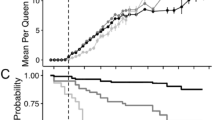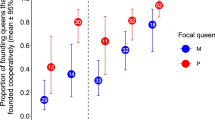Abstract
Understanding social evolution requires us to understand the processes regulating the number of breeders within social groups and how they partition reproduction. Queens in polygynous (multiple queens per colony) ants often seek adoption in established colonies instead of founding a new colony independently. This mode of dispersal leads to potential conflicts, as kin selection theory predicts that resident workers should favour nestmate queens over foreign queens. Here we compared the survival of foreign and resident queens as well as their relative reproductive share. We used the ant Formica exsecta to construct colonies consisting of one queen with workers related to this resident queen and introduced a foreign queen. We found that the survival of foreign queens did not differ from that of resident queens over a period of 136 days. However, the genetic analyses revealed that resident queens produced a 1.5-fold higher number of offspring than introduced queens, and had an equal or higher share in 80% of the colonies. These data indicate that some discrimination can occur against dispersing individuals and that dispersal can thus have costs in terms of direct reproduction for dispersing queens.


Similar content being viewed by others
References
Bennett B (1988) Discrimination of nestmate and non-nestmate sexuals by ants (Hymenoptera: Formicidae). Insect Soc 35:82–91
Beye M, Neumann P, Chapuisat M, Pamilo P, Moritz RFA (1998) Nestmate recognition and the genetic relatedness of nests in the ant Formica pratensis. Behav Ecol Sociobiol 43:67–72
Boomsma JJ, Franks NR (2006) Social insects: from selfish genes to self organisation and beyond. Trends Ecol Evol 21:303–308
Bourke AFG, Franks NR (1995) Social evolution in ants. Princeton University Press, Princeton
Bourke AFG, Green HAA, Bruford MW (1997) Parentage, reproductive skew and queen turnover in a multiple-queen ant analysed with microsatellites. Proc R Soc Lond B 264:277–283
Breed MD, Welch CK, Cruz R (1994) Kin discrimination within honey-bee (Apis mellifera) colonies: an analysis of the evidence. Behav Processes 33:25–39
Breed MD, Diaz PH, Lucero KD (2004) Olfactory information processing in honeybee, Apis mellifera, nestmate recognition. Anim Behav 68:921–928. doi:10.1016/j.anbehav.2003.10.033
Brown WD, Keller L (2002) Queen recruitment and split sex ratios in polygynous colonies of the ant Formica exsecta. Ecol Lett 5:102–109. doi:10.1046/j.1461-0248.2002.00291.x
Brown WD, Liautard C, Keller L (2003) Sex-ratio dependent execution of queens in polygynous colonies of the ant Formica exsecta. Oecologia 134:12–17. doi:10.1007/s00442-002-1072-8
Chapuisat M (1996) Characterization of microsatellite loci in Formica lugubris B and their variability in other ant species. Mol Ecol 5:599–601
Chapuisat M, Goudet J, Keller L (1997) Microsatellites reveal high population viscosity and limited dispersal in the ant Formica paralugubris. Evolution 51:475–482
Cherix D, et al (1991) Alternative reproductive strategies in Formica lugubris Zett. (Hymenoptera Formicidae). Ethol Ecol Evol:61–66
Crozier RH, Pamilo P (1996) Evolution of social insect colonies: sex allocation and kin selection. Oxford University Press, Oxford
Evans JD (1996) Queen longevity, queen adoption, and posthumous indirect fitness in the facultatively polygynous ant Myrmica tahoensis. Behav Ecol Sociobiol 39:275–284
Fortelius W, Rosengren R, Cherix D, Chautems D (1993) Queen recruitment in a highly polygynous supercolony of Formica lugubris (Hymenoptera, Formicidae). Oikos 67:193–200
Fournier D, Keller L (2001) Partitioning of reproduction among queens in the Argentine ant, Linepithema humile. Anim Behav 62:1039–1045. doi:10.1006/anbe.2001.1848
Fournier D, Aron S, Keller L (2004) Significant reproductive skew in the facultatively polygynous ant Pheidole pallidula. Mol Ecol 13:203–210. doi:10.1046/j.1365-294X.2003.02036.x
Gyllenstrand N, Gertsch PJ, Pamilo P (2002) Polymorphic microsatellite DNA markers in the ant Formica exsecta. Mol Ecol Notes 2:67–69. doi:10.1046/j.1471-8286.2002.00152.x
Hamilton WD (1987) Discriminating nepotism: expectable, common, overlooked. In: Fletcher DJC, Michener CD (eds) Kin recognition in animals. Wiley, New York, pp 417–437
Hammond RL, Bruford MW, Bourke AFG (2006) A test of reproductive skew models in a field population of a multiple-queen ant. Behav Ecol Sociobiol 61:265–275. doi:10.1007/s00265-006-0257-2
Hannonen M, Sundström L (2003a) Reproductive sharing among queens in the ant Formica fusca. Behav Ecol 14:870–875. doi:10.1093/beheco/arg069
Hannonen M, Sundström L (2003b) Worker nepotism among polygynous ants. Nature 421:910. doi:10.1038/421910a
Heinze J, Trunzer B, Holldobler B, Delabie JHC (2001) Reproductive skew and queen relatedness in an ant with primary polygyny. Insect Soc 48:149–153. doi:10.1007/PL00001758
Holzer B, Kümmerli R, Keller L, Chapuisat M (2006) Sham nepotism as a result of intrinsic differences in brood viability in ants. Proc R Soc Lond B 273:2049–2052. doi:10.1098/rspb.2006.3553
Keller L (1988) Evolutionary implications of polygyny in the Argentine ant, Iridomyrmex humilis (Mayr) (Hymenoptera: Formicidae): an experimental study. Anim Behav 36:159–165
Keller L (1991) Queen Number, mode of colony founding, and queen reproductive success in ants (Hymenoptera, Formicidae). Ethol Ecol Evol 3:307–316
Keller L (1993a) Queen number and sociality in insects. Oxford University Press, Oxford
Keller L (1993b) The assessment of reproductive success of queens in ants and other social insects. Oikos 67:177–180
Keller L (1995) Social life: the paradox of multiple-queen colonies. Trends Ecol Evol 10:355–360
Keller L (1997) Indiscriminate altruism: unduly nice parents and siblings. Trends Ecol Evol 12:99–103
Keller L, Chapuisat M (1999) Cooperation among selfish individuals in insect societies. Bioscience 49:899–909
Kikuchi T, Tsuji K, Ohnishi H, Le Breton J (2007) Caste-biased acceptance of non-nestmates in a polygynous ponerine ant. Anim Behav 73:559–565. doi:10.1016/j.anbehav.2006.04.015
Komdeur J (2006) Variation in individual investment strategies among social animals. Ethology 112:729–747
Kümmerli R, Keller L (2007a) Contrasting population genetic structure for workers and queens in the putatively unicolonial ant Formica exsecta. Mol Ecol 16:4493–4503
Kümmerli R, Keller L (2007b) Reproductive specialization in multiple-queen colonies of the ant Formica exsecta. Behav Ecol 18:375–383. doi:10.1093/beheco/arl088
Kümmerli R, Keller L (2008) Reproductive parameters vary with social and ecological factors in the polygynous ant Formica exsecta. Oikos 117:580–590. doi:10.1111/j.2007.0030-1299.16207.x
Kümmerli R, Helms KR, Keller L (2005) Experimental manipulation of queen number affects colony sex ratio investment in the highly polygynous ant Formica exsecta. Proc R Soc Lond B 272:1789–1794. doi:10.1098/rspb.2005.3163
Kutter H (1969) Die sozialparasitischen Ameisen der Schweiz. Neujahrsblatt Naturforsch Ges Zürich 5–62
Langer P, Hogendoorn K, Keller L (2004) Tug-of-war over reproduction in a social bee. Nature 428:844–847. doi:10.1038/nature02431
Liang D, Silverman J (2000) “You are what you eat”: diet modifies cuticular hydrocarbons and nestmate recognition in the Argentine ant, Linepithema humile. Naturwissenschaften 87:412–416. doi:10.1007/s001140050752
Maynard Smith J, Szathmary E (1995) The major transitions in evolution. Freeman, Oxford
Nonacs P (1988) Queen number in colonies of social Hymenoptera as a kin-selected adaptation. Evolution 42:566–580
Ozaki M et al (2005) Ant nestmate and non-nestmate discrimination by a chemosensory sensillum. Science 309:311–314
Pamilo P, Seppä P (1994) Reproductive competition and conflicts in colonies of the ant Formica sanguinea. Anim Behav 48:1201–1206
Queller DC, Goodnight KF (1989) Estimating relatedness using genetic markers. Evolution 43:258–275
Queller DC, Strassmann JE (2002) The many selves of social insects. Science 296:311–313. doi:10.1126/science.1070671
Ratnieks FLW, Foster KR, Wenseleers T (2006) Conflict resolution in insect societies. Annu Rev Entomol 51:581–608. doi:10.1146/annurev.ento.51.110104.151003
Reeve HK, Keller L (2001) Test of reproductive skew models in social insects. Annu Rev Entomol 46:347–385. doi:10.1007/s00265-006-0257-2
Rosengren R, Cherix D, Pamilo P (1986) Insular ecology of the red wood ant Formica truncorum. II. Distribution, reproductive strategy and competition. Mitt Schweiz Entomol Ges 59:63–93
Rosengren R, Pamilo P (1983) The evolution of polygyny and polydomy in mound-building Formica ants. Acta Entomol Fenn 42:65–77
Ross KG (1988) Differential reproduction in multiple-queen colonies of the fire ant Solenopsis invicta (Hymenoptera: Formicidae). Behav Ecol Sociobiol 23:341–355
Ross KG (1993) The breeding system of the fire ant Solenopsis invicta, and its effects on colony genetic structure. Am Nat 141:554–576
Rüppell O, Heinze J, Hölldobler B (2002) Intracolonial patterns of reproduction in the queen-size dimorphic ant Leptothorax rugatulus. Behav Ecol 13:239–247
Stuart R, Gresham-Bisset L, Alloway T (1993) Queen adoption in the polygynous and polydomous ant, Leptothorax curvispinosus. Behav Ecol 4:276–281
Sundström L (1997) Queen acceptance and nestmate recognition in monogyne and polygyne colonies of the ant Formica truncorum. Anim Behav 53:499–510
Szathmary E, Maynard Smith JM (1995) The major evolutionary transitions. Nature 374:227–232. doi:10.1038/374227a0
Tarpy DR, Gilley DC, Seeley TD (2004) Levels of selection in a social insect: a review of conflict and cooperation during honey bee (Apis mellifera) queen replacement. Behav Ecol Sociobiol 55:513–523. doi:10.1007/s00265-003-0738-5
Vásquez G, Silverman J (2008) Queen acceptance and the complexity of nestmate discrimination in the Argentine ant. Behav Ecol Sociobiol 62:537–548. doi:10.1007/s00265-007-0478-z
Acknowledgements
We thank R. Kümmerli for technical assistance, the editor and three anonymous reviewers for useful comments. This study was supported by several grants from the Swiss National Science Foundation to M. C. and L. K. This research complies with the laws of Switzerland, where the research was performed.
Author information
Authors and Affiliations
Corresponding author
Additional information
Communicated by Roland Brandl.
Rights and permissions
About this article
Cite this article
Holzer, B., Chapuisat, M. & Keller, L. Foreign ant queens are accepted but produce fewer offspring. Oecologia 157, 717–723 (2008). https://doi.org/10.1007/s00442-008-1101-3
Received:
Accepted:
Published:
Issue Date:
DOI: https://doi.org/10.1007/s00442-008-1101-3




